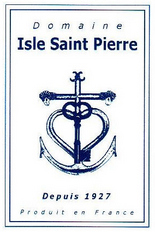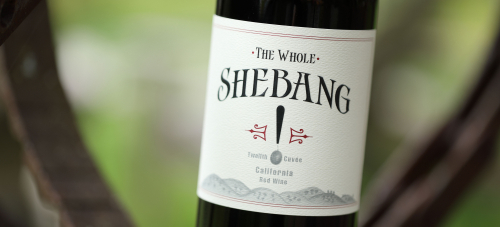Pratsch Gruner Veltliner – Liter – Organic
BODKIN SAUVIGNON BLANC THE VICTOR’S SPOILS – ORGANIC
ISLE ST PIERRE ROSÉ – SUSTAINABLE
Audebert Bourgeuil – Organic
Violet Hill Pinot Noir – Sustainable
Shebang! Red Blend – Sustainable
Cattin Crémant d’alsace rosé-Sustainable
Patrick Girault Le Vallon des Demoiselles Sancerre – sustainable
UNICO ZELLO FIANO Jade and Jasper – ORGANIC, FOLLOWING NATURAL WINE PRACTICES
Domaine Felix Côtes d’Auxerre Pinot Noir – Organic
Raúl Pérez Ultreia St Jacques – Organic
Picayune Red Wine Blend Padlock – Sustainable
 Pratsch Gruner Veltliner – Liter – Organic
Pratsch Gruner Veltliner – Liter – Organic
Pratsch Biohof Pratsch is a relatively small, 35 acre estate comprised of 13 single vineyards in the Niederosterreich region (Lower Austria) all maintained under organic certification for over 10 years by the Pratsch family, Wilhelm and Anneliese and their son, Stefan.
Organic wine growing to them is more than just the elimination of pesticides, fungicides, and artificial fertilizers, but rather part of a larger, holistic philosophy of dedication to the land and the quality of the wines.
On the glacier-formed hills and alluvial soils, the ripening process of the estate-grown grapes is promoted by high, sun-exposed vine trellising, known as the Guyot Double. This tall system combined with the areas winds help cut down the problem of fungal diseases, maintaining dry, unaffected grapes.
Constant hand-pruning and care to the vines are administered in order to further maintain health in the vineyard. Cover crops in and around the vineyards help attract insects and other vine-damaging parasites away from the vines. Natural fertilizers are used to transport nitrogen and other nutrients back to the soils. All of this attention to detail and dedication to the purity of the land by Stefan and the Pratsch family is translated directly into the quality of the wines that are a true reflection of their terroir.
100% Certified Organic Gruner Veltliner. On the nose, this wine is fruit-forward with a touch of apple, peach, and apricot with a slight spice. Fresh and tangy, fine spices, white pepper, and round body.
Best Buy Wine and Spirits and Wine Enthusiast: “Fresh and lively, here’s a wine by the liter to stock up on for summer drinking. It’s limey and herbal with a quenching acidity; for anything doused in chimichurri.” (W&S) “Crisp green pear, a touch of lemon and even some of that much-vaunted pepperiness find their way into this unobtrusive but refreshing white, which also boasts some welcome spritz.” (WE)
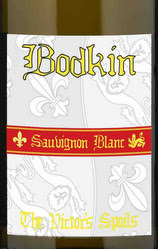 BODKIN SAUVIGNON BLANC THE VICTOR’S SPOILS – ORGANIC
BODKIN SAUVIGNON BLANC THE VICTOR’S SPOILS – ORGANIC
Bodkin Wines was founded by Chris Christensen, an Iowa native, in 2011. His passion for aromatic wines and winemaking led him to create America’s first Sauvignon Blanc with bubbles. In 2013, Andrew Chambers, an Oregon native, joined the brand and they purchased 24 tons and made 1,100 cases of their award-winning Sparkling Sauvignon Blanc. Since that time, Bodkin Wines has produced over 15 varietals of wine, eleven of which were scored at 90 points or higher by Wine Enthusiast. They are consistently growing, year after year, but are determined to keep their presence small and unique. Bodkin Wines is still 100% owned by both Chris and Andrew, two guys living and working hard in Sonoma County.
Winemaker Chris Christensen was named “Winemaker to Watch” by the SF Chronicle in 2017, and has been lauded nationally for his work with Sauvignon Blanc. (We’ll be bringing in several of his sparkling SBs soon). He’s one of the few African American winemakers working today, and we are very happy to support him and his family by bringing in the wine.
Winery notes: “Light and approachable, this high flavor-low alcohol wine is perfect to drink all day long and on into the party hour. Pineapple-guava with accents of tangerines and nectarines dominate the flavors and aromas. This wine pairs well with live music, sunny days, fresh cuisine, cool dudes, and hot babes-so it pairs with pretty much the best things in life. The winemaker calls that winning and to the victor go the spoils. Grip and Sip!”
90 points, Wine Enthusiast: This is a delightfully bright, light and refreshing wine, grassy and herbal within a context of textured grapefruit and lime. It’s lovely and complex with great persistence of acidity.
Pair with lighter foods, like fish, salads, or appetizers; or try as a refreshing aperitivo. The mouth-watering acidity of this wine makes it a perfect foil for fattier dishes, so have fun!
ISLE ST PIERRE ROSÉ – SUSTAINABLE
Founded in 1927, Domaine Isle Saint Pierre is located on a small island in the Rhône River. It is run today by fourth-generation vigneron Julien Henry. The proximity to the water provides a cooling influence that allows the wines to retain great freshness even in the far south of France, and deep well-draining sedimentary soils comprised of sand and silt. Because of the terroir and temperature, they are able to grow varietals that thrive in a Continental climate, such as Merlot, Cabernet Franc, Chardonnay, and Sauvignon.
In 2018, the estate received the Vignerons Développement Durable certification in recognition of its commitment to sustainable wine growing.
Isle Saint Pierre is a small island in the Rhône River, located south of Arles and 10 miles away from the Mediterranean in the heart of the Camargue region.
In 1927, Parisian wine merchant Pierre Chassaing founded Domaine Isle Saint-Pierre and devoted himself to cultivating vines and raising sheep. A few vines remain from that time, together with a flock of 200 sheep that provides the manure needed to nourish the vines. The proximity to the water means that the island enjoys a coastal climate (with a cooling influence from the nearby bodies of water) and deep, well-draining sedimentary soils comprised of sand and silt.
Though the estate dates from the 1920s, it wasn’t until 1972 when the next generation set about replanting the vineyard with noble vines grafted onto American rootstock. Because of the terroir and temperature, they are able to grow varietals that thrive in Continental climates. For red wines as well as for the rosé, the main varieties are Merlot, Cabernet Franc, Petit Verdot, Carmenere, and Arinarnoa (a cross between Merlot and Petit Verdot).
Today, fourth-generation vigneron Julien Henry farms sustainably with careful attention paid to the leaf system of the vine. The goal is to achieve the right balance between grape production and the leaf surface exposed to sunlight. Working the soil enables the vines to establish a deep root system, which protects them from Summer droughts. Through careful viticulture and maintaining low yields, the estate is able to harvest its vineyards by the 15th of September before the arrival of the rains which often fall as the season progresses into fall.
Although the Isle Saint Pierre wines come from the very southern stretches of France, they display wonderful freshness and aromatic appeal. At harvest, as soon as the grapes enter the cellar, they are cooled down to retain freshness. The rosé is a blend of Cab Franc, Merlot, Petit Verdot, Arinarnoa, Tannat, Carménère, Syrah.
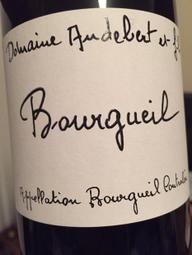 Audebert Bourgeuil – organic
Audebert Bourgeuil – organic
The Audebert family settled in the Bourgueil area in 1839 and now own and farm 100 acres of vineyard in Bourgueil, Saint Nicolas de Bourgueil and Chinon appellations.
Breton specialists, the local term for Cabernet Franc, the Audeberts were discovered by Kermit Lynch who first brought them stardom in the states with sommeliers. Their vines in Bourgueil are planted on a mixture of clay, sand, and limestone with an average vine age of 30 years.
Fermentation is with indigenous yeast in stainless steel. After fermentation, wine is transferred to 600-liter demi-muid barrels where it ages until release.
Like all Loire Valley Cabernet Francs, this wine should be served chilled. That’s right, put it in the fridge for an hour.
Red fruits of black raspberry and cherry meld perfectly with the chalky tones of the soil from which this old vine Cabernet Franc is grown. A lovely citrusy finish tidy’s up a long palate of pure excellence. This red will sing with roast fowl, venison, pork, and all things cheese!
A delicious entry-level Bourgueil; young and brambly, with light herbal notes, possessing a good identity and light enough to have with all sorts of foods.
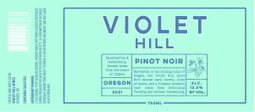 Violet Hill Rogue Valley Pinot Noir – Sustainable
Violet Hill Rogue Valley Pinot Noir – Sustainable
What a find! This lovely light-bodied red comes from the Rogue Valley in Southern Oregon. Stylistically, it splits the difference between Willamette Valley and Californian Pinots. Violet Hill Pinot Noir opens up beautifully once it gets air swirling around in your glass. Look for perfumed dark cherry fruit with a creamy texture, delicate earthiness and elegant finish.
Farmed in an expansive and well-sheltered valley along the Rogue River and its tributaries; the Rogue AVA is bordered by the Cascade Mountains to the east, the Siskiyou Mountains to the north, and the Southern Oregon Coast Range to the West. The AVA is mostly made up of high-elevation sites in mountain country. Despite the ruggedness of the region, the weather is quite mild and warm in the summers making for concentrated and ripe fruit profiles.
Fermented with native yeasts in small batch fermentations, the wine is a representation of the of the people and places that farm and vinify it.
Medium-bodied, with primary aromas of dark cherry, mocha, and floral, that are echoed on the satiny palate, with a bright finish.
James Suckling, 90 points: “Aromas of strawberries, pitted red cherries, hibiscus, and grated nutmeg. Medium-bodied with silky tannins. Pretty red fruit on the palate with a savory, mushroom-tinged character.”
SHEBANG! (SUSTAINABLE)
Sherman and Hooker Shebang is made by Bedrock Wine Company and is a wine crafted from a blend of declassified Syrah, Petite Syrah, and Zinfandel from Bedrock Wine Co., along with selected bulk lots from other small producers.
Shebang is a project by Morgan Twain-Peterson, the son of Ravenswood founder Joel Peterson. Morgan grew up in the world of wine in California. In addition to this project, Morgan also produces tiny amounts of old vine, heirloom red and white blends, Pinot Noir, and Syrah under the Bedrock Wine Co. label. Also noteworthy: Morgan passed the prestigious Master of Wine and has become one of the less than thirty American Masters of Wine!
Sherman & Hooker is named after the two Civil War generals who founded Bedrock Vineyard in 1854. It is a blend of declassified Syrah, Petite Syrah, Zinfandel and friends from Bedrock Wine Co., along with selected bulk lots from other small producers. All of the lots, whether from Morgan or from friends, were aged in French oak, and saw no chips, staves, or other gobbledy-gook. Morgan chose to make the wine a multi-vintage, multi-varietal blend in order to maintain quality at a terrific price point.
Mostly Zinfandel blended with Carignane, Petite Sirah, Mourvedre, Alicante Bouchet, Grenache, Syrah, Barbera and a touch of whites for aromatics. Sourced from several old vine vineyards throughout Sonoma County.
Fermented using native yeasts in stainless steel, and aged in a combination of stainless steel (85%) and French oak (15%)
The informing impulse behind Shebang is to create a wine that is long on deliciousness and low on pretense. We do this by vinifying the wines with the same care and love as the higher end Bedrock wines- picking at respectable sugar levels (not too high!), using only native yeast fermentations, and a trace of good French oak to round things out
It’s a wine that is meant to be the perfect complement to pizza, pasta, burgers, or whatever is on the table. It’s real wine that’s not manufactured or manipulated. The result is a serious bottle of wine with integrity that drinks WAY beyond its price point!
“Morgan Twain-Peterson is one of the most impressive young winemakers I have ever met, and it’s not just because he grew up the son of a famous producer. Making wines at this level requires talent, passion, hard work, and a great palate, none of which is easily inherited. Along with Mike Officer of Carlisle, Twain-Peterson is on a mission to rediscover what he calls California’s old-vine “heritage” vineyards. These historic sites planted by California’s early immigrants, often home to unknown field blends, remain some of the most fascinating vineyards in California. Officer and Twain-Peterson were tired of seeing these old sites gobbled up by industrial-scale wineries, so they decided to do something about it. Bravo.” Antonio Galloni
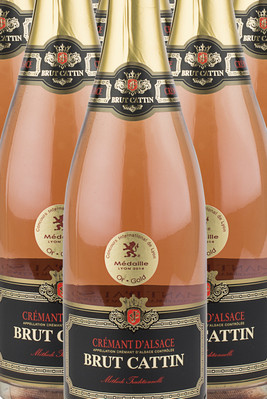 Cattin Crémant d’alsace rosé-Sustainable
Cattin Crémant d’alsace rosé-Sustainable
The Cattin family, of Swiss descent, can trace their arrival in Alsace to around the year 1720. The family settled in the village of Voegtlinshoffen 10km south of the Alsatian wine capital of Colmar. Being that the region had been famous for its wines since the Middle Ages they immediately planted vines and began the viticultural legacy that continues today. The Domain is named for Joseph Cattin who became renowned for his pioneering work in grafting that, at the end of the 19th century, is widely credited for saving some of Alsace’s best vineyards from phylloxera.
Today the Estate is run by Jacques and Jean-Marie Cattin as well as the latest generation, represented by Jacques Jr. They own 50 hectares of vines planted to all the traditional Alsatian varietals and have two separate wineries, one of which is dedicated solely to the production of their incredible crémant wines. The vines are located in the prestigious Upper Rhine and are planted on the mostly SE facing slopes at the base of the Vosges Mountains ranging from 200-400 meters in altitude. The soils vary considerably from compositions of gravel, granite, marl to clay, limestone and sandstone. Most of the Cattin estate vineyards are over 60 years old.
The estate is composed of many small plots located in the southern part of the Colmar region and a staggering 80% of their vineyard land is located on slopes. A broad menu of soils (clay, limestone, sandstone, ferruginous, marl…), combined with big-time diurnal shifts, means an exceptional palate of aromas and flavors.
Cattin uses large old oak foudres to produce some of the region’s most terroir-driven Grand Cru wines such as the legendary Hatschbourg which ranks among the family’s oldest plots.
Over the past several decades, their Crémants have become the house specialty.
100% Pinot Noir – grapes are handpicked. Short maceration to extract the pale salmon color and gentle pressing of the grapes. The first fermentation happens between 64°F and 72°F. The second fermentation happens in bottle (méthode champenoise), and is followed by 15 months of aging on the lees before disgorgement.
A clear and elegant pale salmon color with numerous fine bubbles. The nose is deliciously fruity with notes of freshly squeezed strawberries and raspberries. The palate is refreshing and creamy with fruity aromas such as strawberries and lemon. A clean and long-lasting finish.
90 points, Wine Enthusiast: Rounded, balanced, and harmonious flavors get top marks on this softly pink sparkler. Strawberries and cream, with shortbread and lemon, all unite in perfect unison. The dryness of the palate gives the flavors center stage and provides a fitting, structured autolytic background. This sparkler is classy and delicious, with an ultra clean and lasting finish.
Patrick Girault Le Vallon des Demoiselles Sancerre – sustainable
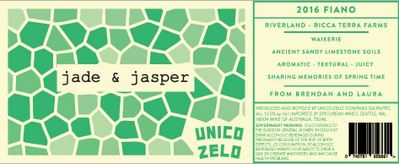 UNICO ZELLO FIANO Jade and Jasper – ORGANIC, FOLLOWING NATURAL WINE PRACTICES
UNICO ZELLO FIANO Jade and Jasper – ORGANIC, FOLLOWING NATURAL WINE PRACTICES
Inspired by an intense passion for the land, Helmed by Brenden and Laura Carter, their wines are crafted to showcase unique sites and soils that Australia has to offer, in styles that are typified by the life and culture of this sunburnt country. Using minimal intervention techniques such as zero irrigation, 100% wild ferment, and no additions of enzymes, nutrients, or sugars, they create organic, vegan, earth-friendly wines that respect the environment and communities around them.
In Brendan and Laura’s words, their aim is to create “Italian-inspired, textural and site-expressive wines” and “Australian examples of Mediterranean varieties in an approachable and jovial fashion.” Since bursting onto the scene in 2014 with their eye-catching, outrageously good value alternative vino, the Carters have spread their wings and their range.
They now make a large suite of wines, including single vineyard examples of Fiano, Nero d’Avola, and Nebbiolo. They are one of the most dynamic winemaking duos in the Adelaide Hills.
Jade and Jasper Fiano – from the winery: “The Alpha & Omega of Unico Zelo. When discovering the ability of Fiano’s incredible to be dry grown in the Riverland, a bonafide desert, it set us on the path that we were set to follow. It also certainly helps that the wine produced from it is nothing short of a delight. Elegant whiffs of jasmine and white peach blossoms, racy and crackling acidity with distinct Fiano texture. One of those white wines that can suit almost any situation calling for a good glass – it’s destined for the lunch table. A Sunshine Slurper.”
Hailing from two different vineyard sites with two different soil types (limestone and clay), provides this wine with complexity and texture unparalleled in the Clare Valley. 100% Fiano with 24 hours skin contact, wild fermentation, natural malolactic fermentation. 100% aging in stainless steel tanks.
Full of white peach blossoms, honeydew, and lemon, all covered in a generous splash of Grannysmith Apple. This continues onto an electric palate, lifted by a rich fruit-sweetness, and sparked to life with crispy acidity.
97 points, Decanter: Change is sweeping through South Australia’s vast Riverland region, with many vineyard owners embracing an array of Mediterranean grape varieties. This is what excites Brendon and Laura Carter of boutique Adelaide Hills winery Unico Zelo, who purchase Fiano from a dry-grown Waikerie vineyard for Jade and Jasper – one of four different Fiano styles they make from a variety of fruit sources. This afable, friendly interpretation is all about citrus freshness and crunchy texture on the mid-palate. Seductive, airy perfume of jasmine, lemon aspen and white peach, anchored on the palate by lemon curd and green apple bite with nashi pear and racy acidity leaving the flavors to linger.
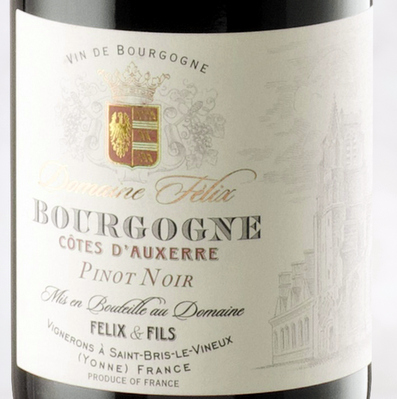 Domaine Felix Côtes d’Auxerre Pinot Noir – Organic
Domaine Felix Côtes d’Auxerre Pinot Noir – Organic
Back in the day, one used to be able to purchase a village-level Côte d’Or red Burgundy in the 20s. Now, those wines are in the high 50-60s! What to do if you are looking for red Burgs that you can drink more casually? Look to the north and south!
“The northernmost appellations of Burgundy, anchored by Chablis, are proving well-positioned for success in a warming climate. Côtes d’Auxerre may be unknown to many, but this juicy, silken Pinot Noir from 17th-century Domaine Félix is about to change all of that!” – David Lynch, wine writer
From one of the oldest producers of Saint-Bris and the Cotes d’Auxerre, Herve Felix and his family run a small estate where they produce a range of artisan wines. Founded by Herve’s ancestors in 1690, the estate has been passed down from generation to generation for over 300 years. Let’s just say they know a thing or two about the land, the grapes, and how to best express both in their wines.
When Herve Felix returned home to Saint-Bris le Vineux in 1987 to take over the family vineyards, he was but one of many who had done so since the family archives first showed a winemaker in the family in 1692. The family think it’s very likely that the tradition goes back even further.
But this is not so unusual in this area of Burgundy known as the Auxerrois. This is the region of Chablis, and of Irancy, villages with a worldwide reputation for fine wine. But it was only in the past few generations that grapes became the mono-culture of the region. Although it was typical in the past for farming families to grow grapes. They grew other crops as well. Wheat and other grains, and here in the Auxerrois, famously, cherries.
So at the time that Herve came back to the farm, his parents were growing grapes, but selling them to the co-ops and negociants. Herve was a pioneer at the time, making his own wine and bottling it. Selling his wine directly to the public rather than passing through the negociants, and developing the family holdings to about 75 acres.
Today they have holding in Chablis, which Herve says is easy to sell because of its reputation. But they also produce a regional appellation Bourgogne Cote d’Auxerre which is a great value in both Chardonnay and Pinot Noir.
The estate’s Cotes d’Auxerre Rouge is 100% Pinot Noir grown in limestone-rich soils. Unlike most of the Pinots grown this far north in Burgundy which tend to be light, lean, and fairly simple, this is an anomaly. Quite rich, dense, and powerful, this glides across the palate with classic Red Burgundy notes of dark cherry, currant, raspberry, spice, and mineral. Powerful and somewhat structured, we recommend decanting this for an hour or two to let the wine come together and show its best “stuff.”
Perfumed and pretty Bourgogne Rouge. Continues the house’s style of balancing brightness with earthiness, a nose of rose petal and small red berries is countenanced by a touch of herbs and steminess. Fruit remains bright on the palate with cranberry and raspberry, with a cooling quality on the palate which renders this wine immensely drinkable. Tannins are ultra fine, with some lead pencil/graphite minerality adding depth to the finish. Everything you’d expect from a well-made entry-level red Burgundy, with poise and definition.
Previous vintage garnered 91 points and these words from the Wine Enthusiast: This is a bold, rich wine, a surprise from this far north in Burgundy. It does, however, carry the weight of alcohol well, giving a wine that has density and a chance to age.

Raúl Pérez Ultreia St Jacques – Organic
Raúl Pérez Pereira is universally considered to be one of the world’s most visionary winemakers. Since he produced his first vintage for his family’s winery in 1994 at age 22, he has been at the forefront of the conversation about what has been called “The New Spain”.
In 2005, he left his family business to strike out on his own, creating Bodegas y Viñedos Raúl Pérez, which quickly became the point of reference for the Bierzo appellation. In the intervening years, he has expanded his sphere of activity to include the appellations of Rías Baixas, Ribeira Sacra, and Tierra de León, but his heart and his home remain in Valtuille de Abajo, the village in Bierzo where his family has been tending vines for well over 300 years.
In addition to numerous other accolades, Raúl was named “Winemaker of the Year” by German publication Der Feinschmecker in 2014 and “Best Winemaker in the World” for 2015 by the French publication Bettane+Desseauve.
In the February 2018 Decanter, Master of Wine Pedro Ballesteros wrote, “Raúl Pérez is the archetype of the intuitive winemaking genius.” A picture of Raúl in that same article is captioned, “Is this the best winemaker in the world?” Raúl would certainly not self-apply any of these superlatives. In fact, his genius is far exceeded by his humility and generosity of spirit. That humility comes through in his wines. These are not “winemaker” wines so much as they are unadulterated expressions of the villages and vineyards from which they hail.
Ultreia St. Jacques is a single-vineyard wine made by Bodegas y Viñedos Raúl Pérez.
The vineyard is located just west of the town of Valtuille de Abajo in the Bierzo DO region. Rather than the robust, earthy side of Mencía, this limited-production cuvée is more about the youthful, fresh, and vivid flavors of the grape.
The word ‘Ultreia’ pays tribute to the many pilgrims that have passed by this site since the 3rd Century, en route to Santiago de Compostela and the crypt of James the Apostle. ‘Ultreia’ comes from the Medieval Latin used by travelers to encourage each other, as they pressed onward toward their destination. The word means “Onward!” and ‘St. Jacques’ is French for St. James.
For centuries, there’s been a heavy French influence in this part of Spain because the pilgrimage originates in four French cities: Paris, Vézelay, Le Puy, and Arles. Many French families from all trades, including vignerons from Burgundy, the Rhone, and Bordeaux, have passed these glorious vineyards to pay homage to James the Apostle. Raúl Pérez is one of Spain’s finest winemakers and some wine trade veterans believe Raul is among a handful of the best winemakers in the world (me among them). Raúl believes great wines are made in the vineyard and he has an uncanny knack for knowing what his vineyards need to achieve their greatest potential.
As his great talent has become known, many winemakers now seek to collaborate with Raúl. Made from an eight acre single vineyard that was planted in 1889, this wine is a brilliant effort that shows the youthful, fresh and mineral sides of the Mencía grape. Of all the wines made by Raul, this is one of his best values. 100% Mencía. Organically grown vines planted in 1889. Tended in sandy soil with small river stones at 1,762 ft. elevation
Pérez’s legend has been growing in the US for several years now; he originally gained international recognition working with his mentor, Alvaro Palacios, on assorted projects throughout northwest Spain (and beyond), but his home base is Bierzo, which is situated right where the Galicia region gives way to Castilla y Léon. From 1993-2004 he was the winemaker at Castro Ventosa, his family’s historic Bierzo winery, after which he founded his eponymous operation in the same village—Valtuille de Abajo. His family owns about 50 acres of vineyards in and around Valtuille, which are broken up into incredibly tiny parcels farmed by many individual growers.
Pérez’s “Ultreia” series follows a Burgundy model: There are a few “village-level” wines at the entry level—of which this “St. Jacques” is one—and then several more limited-production, single-vineyard bottlings. As with the Galician wine zones, Bierzo experiences a cool, wet Atlantic Ocean influence, but as you move eastward, to lower altitudes closer to the Sil River, the influence of the warmer, drier plains to the east can be felt. At higher elevations the Bierzo soils are a mix of slate and granite, transitioning to more “alluvial” material—sand, silt, and clay—in the lower-lying areas. Valtuille is indeed part of the latter “Bierzo Bajo,” although, at elevation, there’s nothing especially bajo about it.
Ultreia St. Jacques is sourced from extremely old vines (some going back to 1900), scattered across a variety of small parcels around Valtuille. In addition to Mencía, which comprises the majority of the blend, there are small amounts of Alicante Bouschet and Bastardo (a.k.a. Trousseau) incorporated into St. Jacques; the wine is about 80% “whole-cluster” fermented (meaning intact grape bunches are crushed and fermented, stems and all) in large oak vats. It is then aged in a mixture of used oak barrels and concrete tanks, and bottled unfined and unfiltered.
Ultreia-St. Jacques is tremendously elegant wine for the money! In the glass, it’s a deep ruby moving to purple/magenta at the rim, with a beguiling nose of pomegranate, plum, red and black raspberry, wet roses and violets, graphite, a hint of eucalyptus, and crushed stones. It is medium-bodied and silky on the palate, the tannins barely perceptible and the acid bright but not sharp. The energetic palate impression is where the Burgundy comparison comes into play—it is easy to drink, but persistent on the finish. And it’s an absolute pleasure to drink now: Decant it about 30 minutes before serving at 60-65 in Burgundy glasses, if you have them. It will easily do double duty on the dinner table with fish and meat, though I’m inclined toward the latter. Don’t hesitate to chill the Bierzo more if you like it cooler.
Picayune Red Wine Blend Padlock – Sustainable
Claire Ducrocq Weinkauf, a French native grew up in Auvergne, France; the land of volcanoes and fabulous cheeses. Her family would typically start a meal with a glass of Sancerre and go on with some Morgon produced by family friends. She graduated from Toulouse Business School and started accumulating international experiences.
Inspired by the power of a Mouton Rothschild 1955, she earned a wine degree in Chile and then embarked for France to work harvest in St Emilion and the Côte du Rhône. While working in South America, she met Paul Hobbs, who hired her to work at Viña Cobos (His award-winning venture in Argentina). Then he brought her to California in 2006. After four years working with Paul Hobbs and numerous opportunities to taste amazing wines and meet wine industry leaders, Claire started a consulting company in 2010. Claire de Lune Consulting focuses on helping fantastic producers including Matthiasson Wines, Anomaly Vineyards, Morlet Family Estate, Cowhorn Winery, and more to grow their businesses. Claire lives in Calistoga with husband Aron Weinkauf-Winemaker at Spottswoode Winery and their son Hugo.
An elegant, round, and rich mid-palate with attractive texture and excellent acidity, Padlock, our Bordeaux blend, is sexy but well-balanced with good depth and length. Blend: 53% Cabernet Sauvignon – 34% Merlot – 13% Malbec
Fermentation: 10 -14 day fermentation in open-top and median-sized fermenters, all-cap irrigated with peak temps of between 80 -85 F. All wine was aged in 60-gallon French barrels for 15 months. Wines were racked every four months and assembled two months before bottling.
Intense fuchsia color, with an exuberant nose of ripe blackberries and cassis with hints of mocha aromas. In the palate, Padlock opens up on more dark fruits with seductive truffle and dark chocolate notes. The texture is rich and intricate, the tannins are firm.



